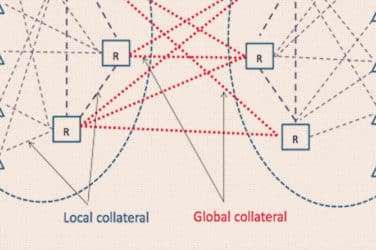The rise of co-location services offered by stock exchanges is a response to firms trying to minimize their remote connectivity and instead place their trading logic closer to the markets.
In the early days, firms would place systems in third-party facilities as close as possible to the exchanges’ own sites.
Today, exchanges allow customers to use their own data centers, in the interest of creating a level playing field, so firms are able to place equipment meters from the exchange systems.
“Almost all exchanges are now offering so-called co-location services, whereby the servers of the participants are co-located in the data center of the exchange and in the immediate physical vicinity of the exchange’s matching engine(s),” said Philip Enness, director of markets infrastructure at IBM. “The link between the servers is optimized through the use of infiniband technology, thus achieving the lowest possible latency for the participants.”
As a result, the low-latency conversations are more related to the microseconds associated with the stack between the co-location hall and the matching-engine environment than in the milliseconds attributed to long-haul networks.
Specialized Hardware
Trading platforms are embedding specialized hardware capable of addressing pre-trade risk, compliance and ultra-low latency execution.
“High frequency trading electronically monitors the markets and transactions based on pre-programmed algorithms,” said Terry Rennaker, vice president at Skanska USA Mission Critical Center of Excellence. “These decisions are instantaneous and their success is subject to the speed at which the decision can be made.”
Micro-second delays can literally cost millions of dollars in lost opportunities.
“If you’re a micro-second late, you might not get that trade, but your competitor will,” Rennaker said. “Even though we are transmitting the data over fiber at the speed of light, feet count.”
Data centers do and will continue play a key role in the distribution, processing, and consumption of market data.

Scott Caudell, VP, IT infrastructure Interactive Data
“They are the central points for the relevant infrastructure to process market data and are strategically positioned near fiber backbones for the onward distribution of that data,” said Scott Caudell, vice president of IT infrastructure at Interactive Data Corp.
They also can be approximate to the raw feed sources themselves, which reduces points of failure, lowers cost, and improves quality.
“Moving forward, as direct normalized and FPGA technology gain prevalence, we’ll see the same dynamic for a distributed and hardware acceleration becoming commonplace,” Caudell said.
For firms leveraging data centers for low-latency functions, a variety of specialist technology are already being deployed.
“These take the form of network devices and models designed and targeted for low latency financial applications, as well as taps, tap aggregation, hardware time-stamping, precision time sources, and packet and performance quality management tools,” Caudell said. “That is in addition to high performance servers, FPGA cards and appliances, and other more conventional IT products.”
Hardware, in the form of appliances called FPGA (field-programmable-gate-array), are designed to enforce pre-market risks in nanoseconds, while preventing impact on latencies that historically have slowed down traditional trading systems and models.
“In general the millisecond level response of modern networks and computing resources obviate the need for specialized hardware for most applications,” said Michael Blundin, general manager of managed services at investment management software provider Vestmark. “A counter-example is high-speed trading where microseconds can make a difference. In this sort of scenario bleeding-edge equipment can make the difference between getting a trade in and missing the window.”
Specialized microchips employing FPGA have near zero impact on latency for governing required checks directed by SEC Rule 15c3-5 (the “Market Access Rule”) and similar regulations from other regulatory governing bodies.
Trading platforms are embedding specialized hardware capable of addressing pre-trade risk, compliance and ultra-low latency execution.
For example, Fixnetix, a provider of outsourced services for ultra-low latency trading, market data, hosting and infrastructure connectivity, and NovaSparks, a deterministic FPGA market data company, have launched a managed FPGA market data service for exchange co-location venues in the U.S. and Europe.
“Any hardware that enables firms to reduce latency or process data more quickly is being installed,” said Craig Mohan, managing director of co-location, data center services at CME Group. “This includes custom built servers with FPGAs, GPUs and custom interconnects. We’ve also seen interested in over-clocked, liquid cooled servers and in purpose-built appliances optimized to solve a particular problem (e.g. in-memory databases, specialized storage arrays).”
Value Proposition
Some exchanges are offering their spare data center space to other execution venues and/or market participants to host a number of services without having to invest in their own data centers.
For the exchanges, this creates a way to compensate for diminishing transaction fee income with new technology services income.
“Several exchanges have also created cloud communities to which they offer cloud computing services, leveraging their data centers for cost-efficient participant processing and/or the provision of value-added services,” said Enness.
“Data centers are literally physically located as close as possible to the actual exchange,” said Rennaker. “Trades are made based on the ability to quickly receive information, analyze that information and execute a trade.”
The emergence of financial ecosystems “allows firms to leverage economies of scale by using dedicated Infrastructure-as-a-Service providers, enabling them able to simplify connectivity, get market data, and connect to trading partners,” said Tony Kroell, vice president of product marketing at data center provider Savvis. “As these ecosystems grow, services and solutions can co-locate in the data center to simplify their delivery of service.”





